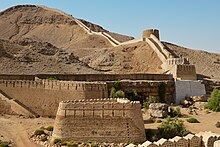Jamshoro (District)
| Jamshoro District | |
| State : |
|
| Province : | Are |
| Seat : | Jamshoro |
| Coordinates : | 25 ° 25 ′ N , 68 ° 15 ′ E |
| Area : | 11,517 km² |
| Residents : | 993,142 (2017) |
| Population density : | 86 inhabitants per km² |
| Time zone : | PST ( UTC + 5 ) |
| Website : | |

|
|

Jamshoro District is an administrative district in Pakistan in Sindh Province . The seat of the district administration is the city of the same name Jamshoro .
The district has an area of 11,517 km² and according to the 2017 census, 993,142 inhabitants. The population density is 86 inhabitants / km². The Sindhi language is spoken by the majority in the district .
geography
The district is located in the south of Sindh Province, which is located in southeastern Pakistan. Jamshoro is located north of the mega city of Karachi .
Administrative division
The district is administratively divided into four tehsil :
history
The district was formed in 2004 from parts of Dadu .
Demographics
Between 1998 and 2017 the population grew at an annual rate of 2.85% and therefore very quickly. Around 44% of the population live in urban regions and around 56% in rural regions. 523,259 men, 469,839 women and 44 transgender people live in 180,922 households , resulting in a gender ratio of 111.4 men per 100 women, which is a common surplus for Pakistan.
| year | population |
|---|---|
| 1972 | 254,318 |
| 1981 | 375.942 |
| 1998 | 582.094 |
| 2017 | 993.142 |
The literacy rate in the years 2014/15 among the population over 10 years of age was 45% (women: 31%, men: 58%) and thus below the average of the Sindh province of 60%.
Web links
Individual evidence
- ↑ a b DISTRICT WISE CENSUS RESULTS CENSUS 2017. August 29, 2017, accessed May 30, 2019 .
- ↑ Pakistani Districts wise Population Census 2017. Accessed May 30, 2019 .
- ^ Pakistan Bureau of Statistics (2016). Pakistan Social and Living Standards Measurement Survey 2014-15. Government of Pakistan, accessed June 29, 2019 .
